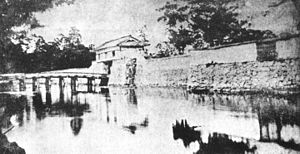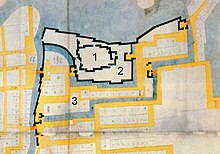Miyazu Castle
| Miyazu Castle | ||
|---|---|---|
|
View of the main gate, before 1870 |
||
| Creation time : | 1584 | |
| Castle type : | Hirajiro (Lower Castle) | |
| Conservation status: | no traces present | |
| Place: | Miyazu | |
| Geographical location | 35 ° 32 '11.6 " N , 135 ° 11' 53.9" E | |
|
|
||
The Miyazu Castle ( Japanese 宮 津城 , Miyazu-jō ) is located in the city of Miyazu in Kyoto Prefecture . In the Edo period , a branch of the Matsudaira resided there as a Fudai daimyo .
Lords of the castle in the Edo period
- From 1601 a branch of Kyōgoku with 120,000 Koku,
- from 1669 a branch of the Nagai with 73,000 koku,
- from 1681 a branch of the Abe with 99,000 koku,
- from 1697 a branch of Okudaira with 90,000 koku,
- from 1717 a branch of the Aoyama with 40,000 Koku and
- from 1758 a branch of the Honjō with 70,000 Koku.
history
Hosokawa Fujitaka (1564-1610) and his son Tadaoki (忠 興; 1563-1646) built the first castle at the end of a bay in 1580. After the Honnōji incident , Fujitaka retired to Tanabe Castle , while Tadaoki remained lord of the castle on Miyazu. During the Battle of Sekigahara , Tadaoki and his troops were on their way to the Kantō area, while Fukitaka was attacked by the western troops. He set Miyazu Castle on fire and holed up at Tanabe Castle, which he successfully defended. - It is not known exactly what the original Miyazu Castle looked like, but it is assumed that it is located in the third castle area of the Edo period castle.
After the Battle of Sekigahara Kyōgoku Takatomo (京 極 孝友; 1572-1622) received the castle. In 1621 he decreed in his will that the province of Tango should be divided into three parts, whereby its ancestor Takahiro (高 広; 1599–1677) received Miyazu. Takahiro repaired the ruined castle, which was like a new construction. Then Takahiro and his son Takakuni (高 国) lost their daimyo status in 1666 because of poor administration. Nagai, Abe, Okudaira and Aoyama followed as lords of the castle, until finally Honjō Sukemasa (本 庄 資 昌; 1744–1762) took over the castle in 1758. The Honjō then remain lords of the castle until the Meiji Restoration in 1868. After that, the castle fell into complete disrepair.
The attachment
The castle used the Ōte river (大 手 川) as an outer moat (外 濠, Sotobori) in the west. There was also the main gate to the castle, the Ōtemon (大 手 門). As usual, the complex consisted of the central area, the Hommaru (本 丸), a second area, the Ni-no-maru (二 の 丸) upstream here in the east and a third area, the San- no-maru (三 の 丸). There was no castle tower (天 守 閣, Tenshukaku), but eight watchtowers (櫓, Yagura) protected the castle.
Today all trenches have been filled in, the castle has disappeared apart from a few remains of the wall under the city. The only relic of the castle is a gate. The "drum gate" (太 鼓 門, Taiko-mon) was moved to the Miyazu Elementary School and serves as the rear entrance to the school. The bridge to the main gate was replaced by a stone bridge in 1888, until this was again replaced by a modern road bridge.
literature
- Kato, Masafumi: Miyazu-jo. In: Miura, Masayuki (ed.): Shiro to jinya. Saikoku-hen. Gakken, 2006. ISBN 978-4-05-604379-2 .
- Papinot, Edmond: Miyazu. In: Historical and Geographical Dictionary of Japan. Reprinted by Tuttle, 1972 edition of 1910 edition. ISBN 0-8048-0996-8 .


